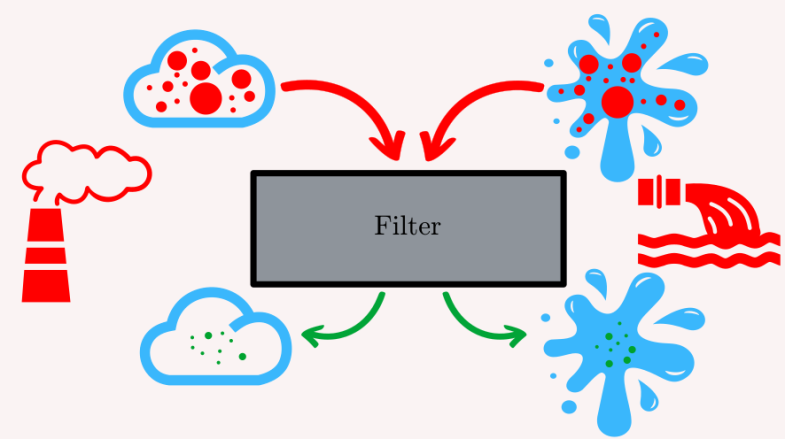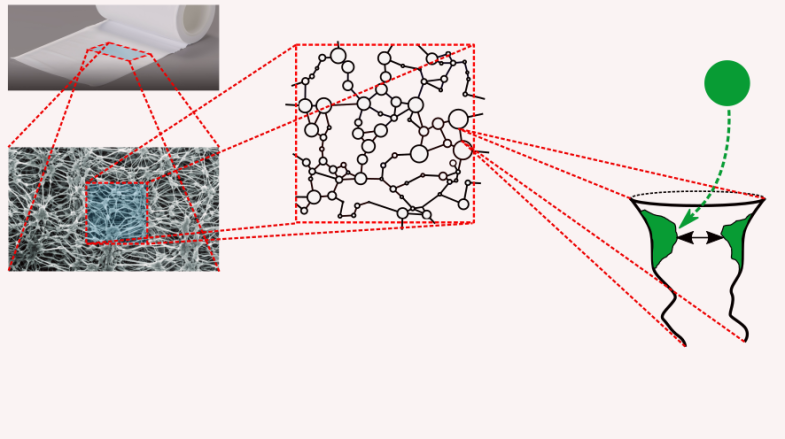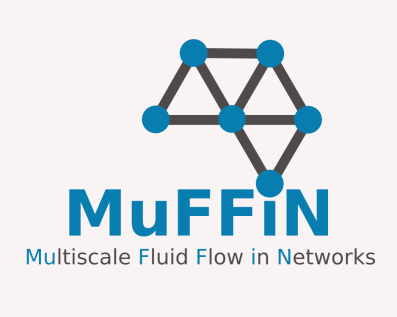Introduction
Filtration is a prevalent industrial process that may prove crucial in addressing some of the most important public health and environmental challenges of our time. In this case study, we discuss the need for more advanced filtration technology. We outline the work accomplished by a collaboration at the University of Oxford, the outcome–impact gap that challenges projects like this, and mathematical software as a potential bridge for that gap.
The importance of filtration
According to the World Health Organisation, air pollution is responsible for 10% of global deaths, with another 6% attributed to polluted water supplies (Figure 1). These alarming statistics highlight the urgent need for improved filtration systems.

Figure 1: During the filtration process, particle-laden fluids are driven through filters. Inside the filter, particles are removed, so that fluid exiting the filter contains fewer particles than fluid entering the filter.
Air filters can significantly reduce the concentration of harmful particulates inhaled due to industrial emissions and wildfires, mitigating respiratory diseases, cardiovascular conditions, and perhaps even cancer (Figure 2).

Figure 2: A woman wears an N95 face mask to protect against lung damage from wildfire smoke [Angela Weiss via Healthline].
Similarly, water filtration is crucial for removing pathogens, heavy metals, and toxic chemicals from contaminated water sources, thereby preventing waterborne diseases such as cholera (Figure 3).

Figure 3: A 10-year-old boy from Myanmar collects water to drink at a camp in Cox’s Bazar, Bangladesh. Due to modern warfare methods, attacks on water and sanitation are one increasingly common cause of polluted water sources. [Patrick Brown via Guardian].
Beyond the health benefits, more efficient filters mean components are replaced less frequently, benefitting the environment by protecting vulnerable ecosystems from waste. These benefits mean that improvement of filtration processes are likely to contribute positively to global initiatives like the United Nations' Sustainable Development Goals (SDGs), particularly SDG 6 (Clean Water and Sanitation) and SDG 13 (Climate Action).
Industrially focused mathematical modelling
As a student of the Engineering and Physical Sciences Research Council (EPSRC)’s Industrially Focused Mathematical Modelling Centre for Doctoral Training (InFoMM CDT) at the University of Oxford's Mathematical Institute, Dr Arkady Wey collaborated with Chris Breward, Jon Chapman, and Ian Griffiths and industrial partners at W.L. Gore & Associates (Gore), Dr Uwe Beuscher and Dr Vasudevan Venkateshwaran, to develop new mathematical frameworks for filtration (Figure 4). One outcome was a multiscale model for fluid flow in a filtration network that predicts filter performance, tracks changes in pore distributions within the filters, and identifies pores that clog first, with the aim of assessing filter lifetime and retention efficiency. The model provides valuable insights that could improve filter functionality and aid filter design.

Figure 4: Diagram of the multiscale model. (Left) An ePTFE membrane filter modelled as a network of edges and nodes. (Right) A particle depositing on a pore wall and decreasing the pore radius. Each pore is modelled as an edge in the network.
The outcome–impact gap
The research was recognised by the Gold STEM for Britain Award, underscoring its potential for impact on both academic and industrial applications. Despite this, it was not obvious how to realise this impact. This is an example of a wider challenge faced by research collaborations between academia and industry: the outcome–impact gap – the difficulties associated with turning research-level outputs into tangible real-world solutions, a crucial step in maximising impact. Academics frequently focus on developing theoretical models presented in technical language, while industry professionals often place more emphasis on practical applications and efficiency. This disconnect can result in valuable academic insights remaining underutilised, and practical industrial challenges lying unaddressed by researchers. Bridging this gap is crucial to leveraging the strengths of both sectors.
A software solution
One possible way to bridge the gap is to use computational code, a mutually understood language. Software packages have the power to translate theoretical research into practical, user-friendly tools that meet industrial needs. These packages are often accompanied by comprehensive and well-presented documentation and intuitive graphical user interfaces that effectively facilitate communication and collaboration between researchers and practitioners. Several existing tools have already made it possible for them to leverage each other's strengths – PyBaMM (a Python package for Battery Mathematical Modelling), for example, is a package developed at University of Oxford that is driving innovation and optimising technological solutions for issues around electricity storage and distribution.
Arkady Wey and the team secured funding from the EPSRC’s Impact Acceleration Account Doctoral Impact Scheme to develop a more modest package of their own. MuFFiN – a package for Multiscale Fluid Flow in Networks (Figure 5) – aims to encapsulate their complex mathematical model in a user-friendly solution that is accessible to other filtration researchers as well as practitioners at Gore and in the wider industrial community. It will include comprehensive documentation and intuitive code available as a developer repository or an easy-to-use installation, aiding knowledge transfer for maximal impact.

Figure 5: Logo for MuFFiN - a Python package for Multiscale Fluid Flow in Networks.
Future Collaboration
The project marks an important step in the collaborative journey between Gore and the University of Oxford, and continues to strengthen the relationship. Indeed, it has already spawned a follow-on project that aims to develop another tool, this time focusing on creating a machine learning model to find optimal filtration regimes. MuFFiN is being used in this follow-on project to generate training data for the machine learning model to learn from.
This development is one example of how software packages may be used to ‘bridge the gap’ between academic research and impactful real-world solutions. Addressing academic–industrial communication barriers via mutually understandable tools strengthens relationships and provides a platform for continued collaborations that are essential to tackle some of the most pressing problems facing humanity.
Here is Arkady Wey introducing the work.


